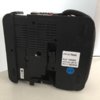In the absence of a spare tire, I opted for the lazy alternative option, and purchased a Tesla tire inflation kit. This is basically a compressor that runs off of the car's 12V outlet, and can pump either air, or air mixed with a goopy liquid sealant intended to help temporarily fix a puncture, to temporize until you can get the car to a proper repair facility.
I was a bit disappointed with the documentation associated with the kit. For example, if one followed the misleading diagram associated with the printed instructions in the Owner's Manual, one could easily break the cover over the sealant canister. Also, the unit was handed to me at the Fremont Service Center in a clear plastic bag (no case). So I set out to add labeling, documentation, and packaging for it before putting it into the Rola trunk organizer that I placed in the footwell along the back of the vehicle (great product, perfect fit).
I printed five labels for the device (using 0.94" white tape in a Brother PT-P700 label printer), and produced a single-page document containing the four pages from the Owner's Manual dealing with the tire kit. I put the result in a small TESLA recycled polypropylene bag I received with a purchase from the store at the factory delivery center. A modest little project, but cheap and tidy. I thought others might appreciate seeing the result.

The front of the unit, with the power cord unwound to expose the power switch. Four labels are visible: POWER Below the power switch), PRESSURE RELIEF VALVE (below and in line with the red button), and, as the far left, a label that provides a space to record the expiration date for the enclosed sealant canister, and instructs the user as to how to properly remove the cover for the canister The label at the top shows the correct place to grasp and pull on to remove the canister cover.

A close-up of the two labels providing instructions for removal of the sealant canister cover. The expiration date for the canister is written on a small piece of Scotch tape so it can be replaced when the canister is replaced.

Label for the inflator adapter compartment on the back of the unit.

Here the kit has the power cord wrapped in its place, obscuring view of the power button, and is sitting in front of the recycled polypropylene bag it will be placed in.

The single-page instruction summary in a plastic sheet protector, trimmed to wrap around kit.

Kit and documentation in the TESLA-branded bag, ready to pop into trunk organizer.
I was a bit disappointed with the documentation associated with the kit. For example, if one followed the misleading diagram associated with the printed instructions in the Owner's Manual, one could easily break the cover over the sealant canister. Also, the unit was handed to me at the Fremont Service Center in a clear plastic bag (no case). So I set out to add labeling, documentation, and packaging for it before putting it into the Rola trunk organizer that I placed in the footwell along the back of the vehicle (great product, perfect fit).
I printed five labels for the device (using 0.94" white tape in a Brother PT-P700 label printer), and produced a single-page document containing the four pages from the Owner's Manual dealing with the tire kit. I put the result in a small TESLA recycled polypropylene bag I received with a purchase from the store at the factory delivery center. A modest little project, but cheap and tidy. I thought others might appreciate seeing the result.

The front of the unit, with the power cord unwound to expose the power switch. Four labels are visible: POWER Below the power switch), PRESSURE RELIEF VALVE (below and in line with the red button), and, as the far left, a label that provides a space to record the expiration date for the enclosed sealant canister, and instructs the user as to how to properly remove the cover for the canister The label at the top shows the correct place to grasp and pull on to remove the canister cover.

A close-up of the two labels providing instructions for removal of the sealant canister cover. The expiration date for the canister is written on a small piece of Scotch tape so it can be replaced when the canister is replaced.

Label for the inflator adapter compartment on the back of the unit.

Here the kit has the power cord wrapped in its place, obscuring view of the power button, and is sitting in front of the recycled polypropylene bag it will be placed in.

The single-page instruction summary in a plastic sheet protector, trimmed to wrap around kit.

Kit and documentation in the TESLA-branded bag, ready to pop into trunk organizer.
Last edited:


